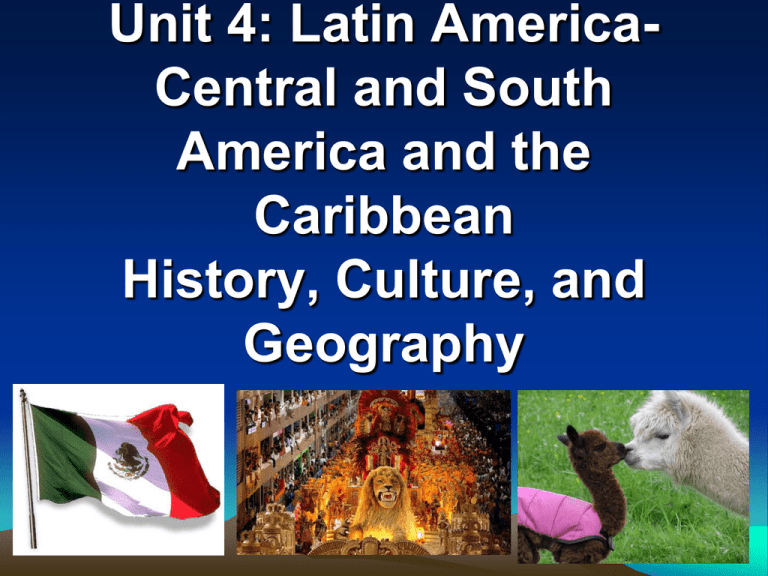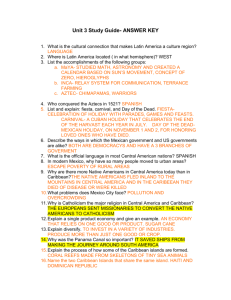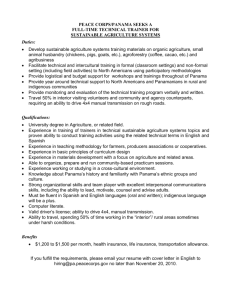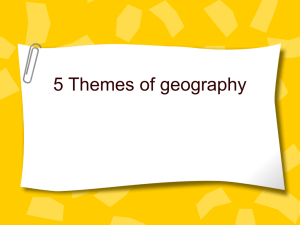Unit 8: Latin America & the Caribbean Cultural Characteristics
advertisement

Unit 4: Latin AmericaCentral and South America and the Caribbean History, Culture, and Geography Central American Important Facts • Lake Nicaragua is the only freshwater lake in the world that has oceanic animal life. • The Panama Canal was built through the narrowest part of Panama to connect the Atlantic and Pacific oceans for shipping. The Panama Canal is a major economic force in Panama. • Civil wars and natural disasters have negatively impacted the economy of Central America. • Central America lies within the tropical climate zone and has a primarily tropical wet/dry climate. Its climates are also influenced by elevation, distance from the sea, and latitude. • The first people to live in Central America were Native American groups. These groups included the Maya, the Olmec, the Nahuatl, and the Chibcha. • Spaniards arrived in Central America in the early 1500s. Later that century, the Spanish set up colonies in Central America. The British also set up a colony in Belize in the 1630s. • Central American Important Facts • In the 1820s, Central America gained independence from Spain, became part of Mexico, and then gained independence again. Guatemala, Honduras, El Salvador, Nicaragua, and Costa Rica formed the United Provinces of Central America. In 1840,these provinces divided into five separate nations. • The majority of people in Central America live in cities. Many people have moved to the cities to escape poverty in rural areas and to find jobs in manufacturing and industry. • Both European and native traditions have influenced culture, religion, art, and literature in Central America. • Central America still struggles with a large gap between wealthy and poor citizens. Many people who live in rural areas work in agriculture, but agriculture often makes money for landowners and not necessarily for workers. South American Important Facts • The world’s largest rain forest, Earth’s richest biological resource, is located in the Amazon Basin. • The Amazon River is the longest river in the Western Hemisphere and the second longest river in the world. It is the largest carrier of freshwater. • Brazil today is a democratic republic where people elect a president and other leaders. In 2010, Brazil elected its fi rst woman president, Dilma Vana Rousseff . • In the 1860s an emancipation movement began in Brazil. By 1888 all slaves were freed. • With 200 million people, a mix of several cultures, Brazil is the world’s fi fth largest country in population. There are European (mostly Portguese, German, and Italian), African, and indigenous American people. • Brazil has the world’s seventh-largest economy, and ranks among its leaders in mining, manufacturing, and agriculture. Brazil is a member of several organizations designed to promote free trade South American Important Facts • South America’s Tropical North consists of fi ve countries and a colony: Ecuador, Colombia, Venezuela, Guyana, Suriname, and French Guiana. • There are different landforms in the region. One landform is the Andes mountain range. Some of the peaks exceed 18,000 feet and about 40 of the peaks are volcanoes. Rainforests cover much of the land in the lower elevations of the region. • Ecuador, Colombia, and Venezuela are primarily Roman Catholic. Other religions that are practiced include: Protestantism, Hindi, and Islam along with indigenous religions. • • Food, music, and other cultural elements reflect each country’s colonial past, ethnic makeup, religious makeup, and geographic location. • • Ongoing struggles over trade and independence, as well as political unrest, continue in the region today. Caribbean Important Facts • Most Caribbean islands have a free enterprise economy, although Cuba has a communist economy. • Tourism is a major contributor to the economies of many Caribbean islands • Languages spoken in the Caribbean islands include Spanish, French, English, and Creole • The culture of the Caribbean islands is influenced by European, African, and indigenous traditions. • Two major indigenous groups living in the Caribbean islands were the Taino in the Greater Antilles and the Caribs in the Lesser Antilles. The Caribs were a violent people, often attacking their neighbors • Many countries in the Caribbean eventually gained independence from their European colonizers. Others remain dependent territories because of their economic ties with the parent country. • Some Caribbean nations have a constitutional monarchy, which is a system of government with a king or queen as the head of state and an elected parliament that makes laws. Caribbean Important Facts • Hundreds of islands are located in the Caribbean Sea, which makes up a western arm of the Atlantic Ocean between North America and South America. More than 30 countries and territories are located in the Caribbean islands. • Three groups of islands make up the land in the Caribbean Sea: the Greater Antilles, the Lesser Antilles, and the Bahamas • Two types of islands in the Caribbean Sea are cays and volcanic islands. Volcanic islands form when lava builds up from volcanic eruptions on the ocean floor. Cays form when coral forms reefs, and the reefs build up to form an island • The climate of the Caribbean islands is a tropical wet/dry climate. Some islands receive very little rain, and others receive an average of almost an inch of rain each day. • The Caribbean islands have few natural resources. Tourism is a major Contributor to the economy of the Caribbean islands. • The term Latin America refers to the Spanish and Portuguese-speaking countries in the Americas. • Before the arrival of The Europeans in the late 15th and early 16th centuries, the region was home to many indigenous people, many of which had advanced civilizations, most notably, the Aztec, Inca and Maya. • Christopher Colomubs landed in the Americas in 1492. Subsequently, the major sea powers in Europe sent expeditions to the New World to build trade networks and colonies and to convert the native peoples to Christianity. • Spain concentrated on building its empire on the Central and Southern parts of the Americas • The Portuguese built their empire in Brazil Ancient Civilizations in Latin America AZTECS in MEXICO MAYANS in GUATEMALA and HONDURAS INCAS in PERU Aztec Maya Inca Location Central America, Mexico Central America South America, along the Andes Time Periods 1200 to 1521 400BC-1517AD Height: 200-900AD 1200-1572AD Capital Tenochtitlan Tikal, Chichen Itza, Copan, Palenque, Mayapan Cuzco Economy Farming (corn, beans, tomatoes, squash) chinampas Farming (corn, beans, squash) Trade Farming (corn, cotton, potatoes) - Terraces Many gods, sun god most important, human sacrifice Many gods, king’s blood is sacred, sacrificed animals and some humans Many gods, some human sacrifice Different classes of people Social System Different classes of people, warriors have high social status Different classes of people Government Very powerful king, highly centralized, war was for captives and tribute Well organized city states each with a king, war was for tribute King at the center of empire, War is for conquest Technology Built monumental architecture, chinampas, calendar Writing, math, monumental architecture, calendar Terraces, irrigation, medicine, monumental architecture, roads Abandoned cities, disappeared End of Civilization Cortes and the Spanish kill the king, the empire ended Civil war and Spanish invasion Contributions Corn, calendar, architecture Calendar, corn, writing, math, architecture Medicine, irrigation, terraces Religion In 1494, SPAIN and PORTUGAL signed a TREATY (Treaty of Tordesillas) that divided control of Central and South AMERICA. Portugal gained the present-day territory of BRAZIL – it became Portugal’s largest COLONY, and Spain gained the rest of Central and South America In the 1500s, Europeans arrived and CONQUERED the AZTECS, MAYANS , and INCAS Aztecs were conquered by Hernando Cortes and Spanish conquistadors in 1521 The Mayans were conquered by Pedro de Alvarado Incas were conquered by Francisco Pizarro in the early 1500s By the 19th century, the Caribbean islands were claimed by FIVE different EUROPEAN nations: SPAIN FRANCE GREAT BRITAIN NETHERLANDS DENMARK When Europeans colonized Latin America and the Caribbean, they brought with them their: 1. LANGUAGE: mostly SPANISH & PORTUGUESE, but also ENGLISH, FRENCH, and DUTCH *There are also hundreds of INDIGENEOUS languages still spoken in Latin America today 2. Religion: ROMAN CATHOLICISM Dominant religion of MEXICO and CENTRAL AMERICA BRAZIL has the LARGEST Catholic population in the world Many beautiful CATHEDRALS can be found in Latin America AFRICAN INFLUENCES After establishing colonies, Europeans ENSLAVED native peoples in the CARIBBEAN and BRAZIL to work on SUGAR PLANTATIONS After many natives DIED from DISEASE and MISTREATMENT, Europeans brought AFRICANS over the ATLANTIC OCEAN by force to REPLACE the natives → this began the ATLANTIC SLAVE TRADE More Africans were brought to BRAZIL than to any other area in the Americas → an estimated 3.6 MILLION total (nine times as many brought to the English colonies) By 1820, EIGHT TIMES as many Africans as Europeans had arrived in the Caribbean and SIX TIMES as many Africans as Europeans had arrived in Brazil. SOCIAL STRUCTURE Europeans MEZTIZOS Eventually the Pure Native Americans NATIVES, EUROPEANS, and AFRICAN SLAVES AFRICANS began to INTERMARRY. MESTIZO: Someone This led to a very who is part NATIVE rigid SOCIAL (Indian) and part STRUCTURE EUROPEAN (Spanish) MUSIC REGGAE CALYPSO (TRINIDAD) STEEL DRUMS (TRINIDAD) (JAMAICA) TRADITIONAL DANCES BOLERO → Spanish in origin, adapted in Cuba CHA-CHA → Cuban, derived from the mambo MAMBO → Cuban, grew popular at end of WWII MERENGUE → origins in Haiti and D.R. SALSA → developed by Puerto Ricans in New York SAMBA → native Brazilian dance TANGO → originated in Argentina FUTBOL The game of FUTBOL (Spanish) or FUTEBOL (Portuguese) is played throughout Latin America and the Caribbean. In the United States the game is called SOCCER PELE is one of the most famous soccer players in history. He scored 1,281 goals in his 22-year career. FOOD Caribbean meals often include SPICES, BEANS, RICE, FRUIT, and COCONUT MILK. Popular Caribbean dishes include ARROZ con POLLO (chicken with rice), Jamaican JERK CHICKEN, and CURRIED GOAT STEW. Ingredients in Mexican dishes include CORN, TOMATILLOS, FRIJOLES, and CHILES Popular Mexican dishes are TACOS, ENCHILADAS, EMPANADAS, and QUESADILLAS ART & LITERATURE DIEGO RIVERA FRIDA KAHLO GABRIEL GARCIA MARQUEZ POPULATION & CITIES Years of colonization led to a DISPARITY (GAP) of income DISTRIBUTION and contributed to an extreme DIVIDE between the RICH and those in POVERTY In Latin America there is NOT a large MIDDLE CLASS Part of the reason for the DISPARITY OF INCOME DISTRIBUTION is because a very SMALL % of the population owns MOST of the land in Latin America Since most people do not own a lot of land, they can only grow enough food to survive on. This is known as SUBSISTENCE FARMING. In addition, some people in Mexico work on EJIDOS (COMMUNALLY OWNED and operated farms) Latin America has been experiencing RAPID POPULATION GROWTH in recent years because of IMPROVED standards of living. Because of the POVERTY in RURAL areas, people move to the CITIES to find JOBS and have a better life. People moving to cities is called URBANIZATION Many of the islands in the Caribbean are densely populated More than 85% of people in ARGENTINA, CHILE, and URUGUAY live in cities The steady flow of people into cities has caused several MEGACITIES to form - a megacity has at least 10 MILLION people living there MEXICO CITY, Mexico SANTIAGO, Chile RIO DE JANEIRO, Brazil BUENOS AIRES, Argentina One problem associated with these megacities is POLLUTION. Mexico City has a problem with SMOG because the city is surrounded by mountains which trap the polluted air. Another major problem associated with Latin American megacities is that the INFRASTRUCTURE (systems that serve a city – communication, transportation, schools, etc.) cannot keep up with the growing populations. This leads to people moving out of the cities, known as OUT-MIGRATION. They move to places called SQUATTER SETTLEMENTS. Squatter settlements are called by several names: - FAVELAS (Brazil) - ranchos (Venezuala) - barriadas (Peru) - colonias letarias (Mexico) A SQUATTER is a person who lives in these settlements because they cannot afford to buy land LEGALLY Squatter settlements lack services and infrastructure such as CLEAN WATER, ELECTRICITY, SCHOOLS, and market places Countries We will Look at • • • • • • • Cuba Haiti Dominican Republic Panama Brazil Peru Argentina Cuba Cuba • Communist Government - a system of government in which the state plans and controls the economy and a single -- often authoritarian -- party holds power; state controls are imposed with the elimination of private ownership of property or capital. • Before Fidel Castro's 1959 revolution, Cuba was one of the most advanced and successful countries in Latin America 72% (2013 est.) Cuba • Language- Spanish • Religion- 59% Christian (mostly Roman Catholic), 23% unaffiliated • GDP per Captia- $10,200 • Labor force by OccupationAgricultural 18% Industry 10% Service 72% Cuba • Cuban culture is influenced by its melting pot of cultures, primarily those of Spain and Africa. • Cuban cuisine is a fusion of Native American Taino food, Spanish, African, and Caribbean cuisines. Some Cuban recipes share spices and techniques with Spanish and African cooking, with some Caribbean influence in spice and flavor. Haiti Haiti • Located on the island of Hispaniola, in the Greater Antilles archipelago of the Caribbean • First independent nation of Latin America and the Caribbean, the second republic in the Americas • It is one of only two independent nations in the Americas (along with Canada) to designate French as an official language • 66.4% of the Land in Haiti is use for agriculture • Language: French (official), Creole (official) • 83.2% Christianity and 2.1% Voodoo • Many Haitians practice elements of voodoo in addition to another religion, most often Roman Catholicism; voodoo was recognized as an official religion in 2003 Haiti • Haitian culture has a unique cultural identity consisting of a large blend of traditional customs of French and African, mixed with sizeable contributions from the Spanish and indigenous Taíno culture • Haitian cuisine is similar to the rest of the Latin-Caribbean While the cuisine is unpretentious and simple, the flavors are bold and spicy that demonstrate a primary influence of African culinary aesthetic, paired with a very French sophistication with notable derivatives coming from native Taíno and Spanish techniques • Haitian music combines a wide range of influences drawn from the many people who have settled on this Caribbean island. Haiti • • • • The median age in Haiti is 22.5 years Life expectancy- 62.5 years GDP per capita – $1,200 Jean Lafitte – a French pirate who operated around New Orleans and Galveston on the Gulf Coast of the United States; was born in Port-au-Prince around 1780 • Haiti depends on NGOs (Non Governmental Organizations) for support Haiti’s natural resources and proximity to regional capitals and trade centers are definite assets to the region. The development of Haiti during the French colonial period as a sugar plantation was also an advantage. Today, it is a free market economy that lends itself to low costs in labor, but recent destruction of their infrastructure due to earthquakes/hurricanes has made the region vulnerable. Dominican Republic Dominican Republic • The Dominican Republic is a Caribbean nation that shares the island of Hispaniola with Haiti to the west. • First permanent European settlement in the Americas • The Dominican Republic is the most visited destination in the Caribbean • The Dominican Republic is a tropical, maritime nation • The Dominican Republic is a representative democracy or democratic republic • 2014 GDP per capita of $12,803 • Tourism is one of the fueling factors in the Dominican Republic's economic growth. The Dominican Republic is the most popular tourist destination in the Caribbean Dominican Republic • 63% of the population lived in urban areas. • The population of the Dominican Republic is mostly Spanish-speaking • The culture and people of the Dominican Republic are a mixture of the cultures of the Spaniard colonists, African slaves, and Taíno natives. European, African and Taíno cultural elements are most prominent in food, family structure, religion and music. Many Arawak/Taíno names and words are used in daily conversation and for many foods native to the Dominican Republic • Roman Catholic 95%, other 5% • Labor Force by occupation- agriculture: 14.4%, industry: 20.8% services: 64.7% • Life Expectancy - 77.97 years • Dominican cuisine is predominantly Spanish, Taíno, and African. The typical cuisine is quite similar to what can be found in other Latin American countries, but many of the names of dishes are different. Panama Panama • Panama was inhabited by several indigenous tribes prior to settlement by the Spanish in the 16th century • Panama has the second largest economy in Central America • Panama, under Spanish rule for almost 300 years (1538– 1821) • Panama has a tropical climate • Panama is a democratic republic Country. • Tourism in Panama is rapidly growing • Ethnic groups in Panama include Mestizo people. Black, or Afro-Panamanians account for 15-20% of the population, and in addition, black ancestry is present in 50%, or half the population of Panama. Panama • Spanish is the official and dominant language. The Spanish spoken in Panama is known as Panamanian Spanish • 75% to 85% of the population identifies itself as Roman Catholic and 15%–25% as Protestant. • 94.1% of the population was literate • Panamanian Cuisine is a mix of African, Spanish, and Native American techniques, dishes, and ingredients, reflecting its diverse population. Since Panama is a land bridge between two continents, it has a large variety of tropical fruits, vegetables and herbs that are used in native cooking. Common ingredients are Maize, rice, wheat flour, plantains, yuca , beef, chicken, pork and seafood • The U.S. influence in Panama can be seen in the country's sports. Baseball is Panama's national sport Panama • • • • Urban population: 66.6% of total population (2015) Life Expectancy 78.47 years $19,500 GDP per Capita Labor force - by occupation: agriculture: 17%, industry: 18.6%, services: 64.4% (2009 est.) Panama • Revenue from canal tolls continues to represent a significant portion of Panama's GDP, although commerce, banking, and tourism are major and growing sectors. Panama’s Transportation Corridor: PANAMA CANAL- shorten the distance from the East Coast to the West Coast Speeding up travel and Shipping Panama continues to be one of the major transportation corridors of the world. Brazil Brazil • The slave trade brought Africans to Brazil; thus, recreating Africa in Brazil, namely through religion, food, music, dance, etc. • most Brazilians speak Portuguese Peru • 10-13 million inhabitants of Andean Peru still speak Quechua, the language of the Inca – Since Peru was the epicenter of the Inca Empire before Spanish colonization in the late 1520s, there are historically more indigenous people there. Argentina • 97% of Argentinians are of European ancestry • Argentina could be viewed as the epicenter of European immigration historically, especially for refugees; thus, the low number of indigenous people who reside in Argentina. Likewise, Argentina is a recreation of European culture, society, political structures and cities, especially seen in its architecture •Regions in South America – Brazil, Argentina, Peru Invaded by Spain, Portugal, France and others ◦Natives were conquered by European nations ◦Lands were colonized by European nations; lands and natives were exploited ◦Immigration: received more slaves from Africa than the United States; was (like the US and Canada) a primary destination for emigration from Europe and other parts of the world in the 19th century; due to the economic instability in some of these countries, people have emigrated from the region and migrated to North America in search for a better life •Regions in South America – Brazil, Argentina, Peru • Predominately Spanish-speaking with the exception of Brazil where Portuguese is the official language, a result of Portuguese and Spanish colonization • Blended culture and society because of the mixing of enslaved Africans, American Indian tribes and European colonizers to the region; the region received more enslaved Africans that did other regions including the United States via the trans-Atlantic slavery trade • Economic systems tend to rely on the extraction of natural resources, such as mining in Peru, as the region was the supplier for colonial powers; Brazil has made significant economic development; Argentina developed ranching activities on a wide-scale after the introduction of cattle and horses to the region in the Columbian Exchange Regions in South America – Brazil, Argentina, Peru Trade: historically, the Columbian Exchange played an important role in what was being traded between the South American region and Europe. Although agricultural goods remain important, today South America’s economy is based primarily on exports such as petroleum and finished goods.





